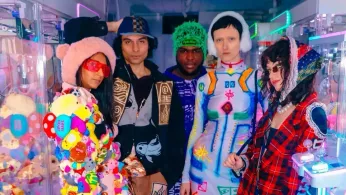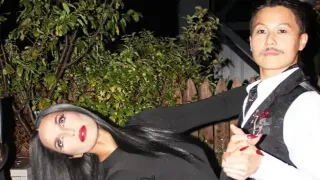
6 hours ago
From Ritual to Runway: DYKEMINT’s Radical Queer Couture Reshapes Fashion Activism
READ TIME: 4 MIN.
At the September 2025 DapperQ New York Fashion Week Show, a new name echoed in the Brooklyn Museum’s halls: DYKEMINT. The label, founded by non-binary, sapphic designer Val Minter, shattered expectations with a collection that was equal parts wearable manifesto and love letter to queer community rituals. In an era marked by mounting censorship of LGBTQ+ art and fashion exhibitions, DYKEMINT’s debut was more than a runway show—it was a declaration of survival, joy, and radical visibility .
Val Minter’s journey into fashion began far from fashion’s traditional capitals. Raised in a working-class, multiracial family in the Pacific Northwest, Minter’s earliest memories are of thrift stores, drag shows, and community potlucks—a world where clothing was both armor and expression, repurposed and reclaimed as needed. Their work is deeply shaped by this background: “I learned early on that what you wear can signal safety, danger, kinship, or protest,” Minter shared in a post-show interview with DapperQ .
After moving to New York in 2021, Minter apprenticed with several independent queer designers and immersed themselves in Brooklyn’s underground ballroom and sapphic party scenes. There, they absorbed the codes—bandanas, carabiners, slogan tees, repurposed workwear—that serve as both identification and in-jokes for queer communities, especially for those on the sapphic and non-binary spectrum .
DYKEMINT’s creative philosophy is rooted in the idea that fashion is both a ritual and a site of resistance. Minter’s debut collection, “Flagging Futures,” drew inspiration from the hanky code—a historical system of colored bandanas used by queer people to signal desires and identities. But rather than nostalgia, Minter reimagined the code for the present: acid-green sashes , lavender boiler suits , and oversized jackets emblazoned with reclaimed slurs and activist slogans.
“We’re not just referencing queer history—we’re reworking it for a generation that refuses to be defined by binaries or limited by mainstream narratives,” Minter told Autostraddle in a feature about new queer designers at the Met Gala .
The show was punctuated by models—many of them trans, non-binary, or disabled—walking in pairs, hand-in-hand, sometimes pausing mid-runway to exchange coded objects: a whistle, a zine, a lock of hair. Each gesture nodded to the rituals of queer friendship, romance, and protest. The soundtrack mixed snippets of spoken-word poetry with audio from past Pride marches, further blurring the line between runway and rally .
What distinguishes DYKEMINT isn’t just aesthetic innovation, but the label’s commitment to embedding community rituals and language into every garment. Sapphic slang—like “usies” and “fae-mily”—are stitched discreetly into breast pockets or jacket linings, offering secret affirmations to those in the know. Reclaimed “slur shirts” are constructed from upcycled textiles sourced at community swap-meets, turning histories of exclusion into garments of pride and resilience .
Minter’s approach echoes the broader 2025 queer fashion movement, where clothing is understood as both a tool for identity formation and a form of protest. At this year’s NYC Pride, DYKEMINT pieces became instantly recognizable: mesh vests layered over harnesses, pastel buzzcuts under embroidered bucket hats, and “chosen kin” bomber jackets—each look a deliberate act of affirmation and resistance .
Beyond the runway, DYKEMINT engages in direct activism. Profits from the “Flagging Futures” capsule were donated to the Transgender Law Center and local mutual aid funds. The brand also runs regular “Sew & Tell” workshops in Brooklyn, where queer youth can learn basic sewing, zine-making, and the history of protest fashion. These workshops, open to all genders and abilities, foster intergenerational dialogue and skill-sharing, strengthening the fabric of queer community on and off the stage .
DYKEMINT’s 2025 has been marked by several notable milestones:
- Their NYFW debut at DapperQ’s 10th Annual Show drew coverage from DIVA Magazine and EDGE Media Network, with praise for centering trans and sapphic experiences in both casting and design .
- DYKEMINT collaborated with the Brooklyn Museum on an exhibition tracing the history of queer protest fashion, situating their garments alongside archival materials from ACT UP and the Lesbian Avengers .
- The brand’s “Flagging Futures” mesh tops and slogan jackets were worn by several LGBTQ+ musicians and activists at WorldPride 2025, reigniting conversations about the role of clothing in queer protest .
This wave of attention coincides with a broader movement towards intersectionality, size inclusivity, and accessibility in queer fashion. DYKEMINT, like peers such as Berriez and Official Rebrand, offers extended sizing and adaptive features, challenging the industry to meet the needs of all bodies, not just those that fit mainstream standards .
DYKEMINT’s rise signals a shift in queer fashion from the commercialized “Pride merch” of past decades to garments that foreground personal narrative, community ritual, and social change. In the words of DapperQ’s executive producer Anita Dolce Vita, “Our 10th Annual Show is not just fashion; it’s defiance, celebration, and survival. DYKEMINT embodies that ethos—turning every runway into a site of memory and resistance” .
As queer art faces renewed threats of censorship and erasure, designers like Val Minter are making the case that fashion is not only about what we wear, but how we live, remember, and organize. DYKEMINT’s commitment to ritual, activism, and radical inclusivity makes them not just a new name in fashion, but a vital force in shaping what queer community—and queer resistance—can look like in 2025 and beyond .






